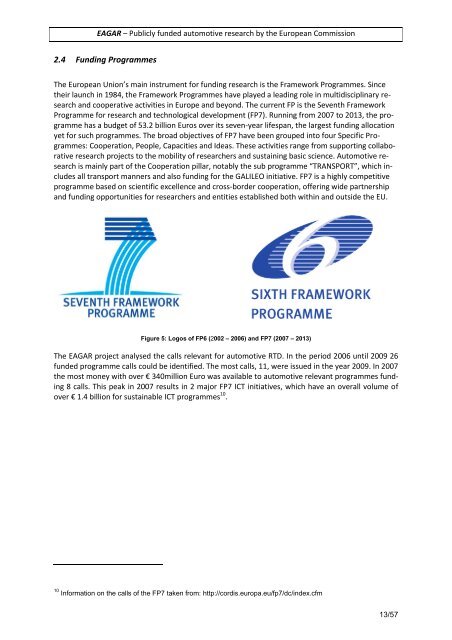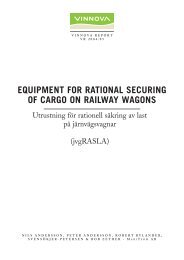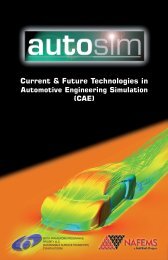Publicly funded automotive research in EU.pdf - EAGAR
Publicly funded automotive research in EU.pdf - EAGAR
Publicly funded automotive research in EU.pdf - EAGAR
You also want an ePaper? Increase the reach of your titles
YUMPU automatically turns print PDFs into web optimized ePapers that Google loves.
<strong>EAGAR</strong> – <strong>Publicly</strong> <strong>funded</strong> <strong>automotive</strong> <strong>research</strong> by the European Commission<br />
2.4 Fund<strong>in</strong>g Programmes<br />
The European Union’s ma<strong>in</strong> <strong>in</strong>strument for fund<strong>in</strong>g <strong>research</strong> is the Framework Programmes. S<strong>in</strong>ce<br />
their launch <strong>in</strong> 1984, the Framework Programmes have played a lead<strong>in</strong>g role <strong>in</strong> multidiscipl<strong>in</strong>ary <strong>research</strong><br />
and cooperative activities <strong>in</strong> Europe and beyond. The current FP is the Seventh Framework<br />
Programme for <strong>research</strong> and technological development (FP7). Runn<strong>in</strong>g from 2007 to 2013, the programme<br />
has a budget of 53.2 billion Euros over its seven-year lifespan, the largest fund<strong>in</strong>g allocation<br />
yet for such programmes. The broad objectives of FP7 have been grouped <strong>in</strong>to four Specific Programmes:<br />
Cooperation, People, Capacities and Ideas. These activities range from support<strong>in</strong>g collaborative<br />
<strong>research</strong> projects to the mobility of <strong>research</strong>ers and susta<strong>in</strong><strong>in</strong>g basic science. Automotive <strong>research</strong><br />
is ma<strong>in</strong>ly part of the Cooperation pillar, notably the sub programme “TRANSPORT”, which <strong>in</strong>cludes<br />
all transport manners and also fund<strong>in</strong>g for the GALILEO <strong>in</strong>itiative. FP7 is a highly competitive<br />
programme based on scientific excellence and cross-border cooperation, offer<strong>in</strong>g wide partnership<br />
and fund<strong>in</strong>g opportunities for <strong>research</strong>ers and entities established both with<strong>in</strong> and outside the <strong>EU</strong>.<br />
Figure 5: Logos of FP6 (2002 – 2006) and FP7 (2007 – 2013)<br />
The <strong>EAGAR</strong> project analysed the calls relevant for <strong>automotive</strong> RTD. In the period 2006 until 2009 26<br />
<strong>funded</strong> programme calls could be identified. The most calls, 11, were issued <strong>in</strong> the year 2009. In 2007<br />
the most money with over € 340million Euro was available to <strong>automotive</strong> relevant programmes fund<strong>in</strong>g<br />
8 calls. This peak <strong>in</strong> 2007 results <strong>in</strong> 2 major FP7 ICT <strong>in</strong>itiatives, which have an overall volume of<br />
over € 1.4 billion for susta<strong>in</strong>able ICT programmes 10 .<br />
10 Information on the calls of the FP7 taken from: http://cordis.europa.eu/fp7/dc/<strong>in</strong>dex.cfm<br />
13/57

















